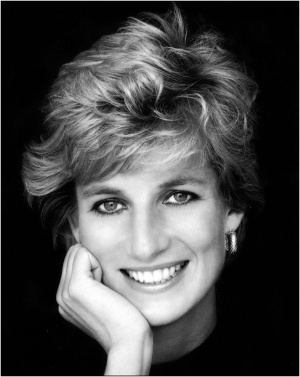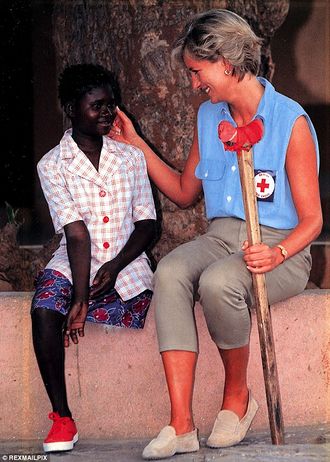Difference between revisions of "Diana Spencer"
(Tidy) |
m (constitutes British royal family) |
||
| (7 intermediate revisions by 4 users not shown) | |||
| Line 1: | Line 1: | ||
{{person | {{person | ||
|image=Princess_Diana.jpg | |image=Princess_Diana.jpg | ||
| + | |constitutes=British royal family | ||
|wikipedia=https://en.wikipedia.org/wiki/Diana,_Princess_of_Wales | |wikipedia=https://en.wikipedia.org/wiki/Diana,_Princess_of_Wales | ||
|birth_date=1 July 1961 | |birth_date=1 July 1961 | ||
| Line 9: | Line 10: | ||
|death_place=Pitié-Salpêtrière Hospital, Paris, France | |death_place=Pitié-Salpêtrière Hospital, Paris, France | ||
|religion=Church of England | |religion=Church of England | ||
| + | |birth_name=Diana Frances Spencer | ||
|employment= | |employment= | ||
}} | }} | ||
| − | + | '''Diana Princess of Wales''' was the first wife of [[Prince Charles]], eldest child and heir apparent of [[Queen Elizabeth II]]. She died on 31 August [[1997]] after a [[Diana Princess of Wales/Death|suspicious car crash]].<ref name=ug680/> | |
| − | |||
| − | |||
| − | |||
| − | '''Diana Princess of Wales''' was the first wife of [[Prince Charles]], eldest child and heir apparent of [[Queen Elizabeth II]]. She died on 31 August 1997 after a [[Diana Princess of Wales/Death|suspicious car crash]].<ref name=ug680/> | ||
==Background== | ==Background== | ||
| − | Diana was born into an aristocratic British family with royal ancestry as the Honourable Diana Frances Spencer. She was the fourth child of [[Viscount Althorp]] and Frances Viscountess Althorp (born Frances Ruth Roche), the daughter of British aristocrat Maurice Roche, 4th Baron Fermoy. Rumours which surfaced after her death suggested that Diana's father was in fact billionaire financier [[Sir James Goldsmith]].<ref>[http://www.dailymail.co.uk/tvshowbiz/article-315244/Were-Diana-Jemima-sisters.html "Were Diana and Jemima sisters?"]</ref> After her parents' divorce, she was raised in Park House, which was situated near to the Sandringham estate, and was educated in England and Switzerland. Diana became ''Lady'' Diana Spencer after Viscount Althorp inherited the title of Earl Spencer in 1975. She became a public figure with the announcement of her engagement. | + | Diana was born into an aristocratic British family with royal ancestry as the Honourable Diana Frances Spencer. She was the fourth child of [[Viscount Althorp]] and Frances Viscountess Althorp (born Frances Ruth Roche), the daughter of British aristocrat Maurice Roche, 4th Baron Fermoy. Rumours which surfaced after her death suggested that Diana's father was in fact billionaire financier [[Sir James Goldsmith]].<ref>[http://www.dailymail.co.uk/tvshowbiz/article-315244/Were-Diana-Jemima-sisters.html "Were Diana and Jemima sisters?"]</ref> After her parents' divorce, she was raised in Park House, which was situated near to the Sandringham estate, and was educated in England and Switzerland. Diana became ''Lady'' Diana Spencer after Viscount Althorp inherited the title of Earl Spencer in [[1975]]. She became a public figure with the announcement of her engagement. |
| − | + | [[image:Diana in Angola.jpg|330px|thumb|left|Diana Spencer highlighting the continuing danger of [[land mine]]s.]] | |
| − | Her wedding to the Prince of Wales on 29 July 1981 was held at St Paul's Cathedral and seen by a global television audience of over 750 million. While married, Diana bore the titles Princess of Wales, Duchess of Cornwall, Duchess of Rothesay, Countess of Chester and Baroness of Renfrew. | + | Her wedding to the Prince of Wales on 29 July [[1981]] was held at St Paul's Cathedral and seen by a global [[television]] audience of over 750 million. While married, Diana bore the titles Princess of Wales, Duchess of Cornwall, Duchess of Rothesay, Countess of Chester and Baroness of Renfrew. |
==Anti-landmines== | ==Anti-landmines== | ||
| − | Diana received recognition for her charity work and for her support of the International Campaign to | + | Diana received recognition for her charity work and for her support of the International Campaign to ban [[landmines]]. From [[1989]], she was the president of Great Ormond Street Hospital for children, in addition to dozens of other charities. |
==Plans to campaign on behalf of dispossessed Palestinians== | ==Plans to campaign on behalf of dispossessed Palestinians== | ||
| − | Ex-[[MI5]] [[whistleblower]] [[Annie Machon]] says that, at the time of her death, Diana was at an advanced stage of planning to campaign on behalf of the dispossessed people of Palestine - See the video right. | + | Ex-[[MI5]] [[whistleblower]] [[Annie Machon]] says that, at the time of her death, Diana was at an advanced stage of planning to campaign on behalf of the dispossessed people of [[Palestine]] - See the video right. |
==Death== | ==Death== | ||
| − | {{FA|Diana | + | {{FA|Diana Spencer/Premature death}} |
| + | {{YouTubeVideo | ||
| + | |code=pucWT_YKJgA | ||
| + | |width=310 | ||
| + | |height=250 | ||
| + | |caption=[[Annie Machon]] on the Death of Princess Diana | ||
| + | }} | ||
Diana died on 31 August 1997 in Paris after a car crash. The {{on}} of this is that she was "unlawfully killed".<ref>http://www.bbc.com/news/uk-23741483</ref> This has nevertheless been obscured by {{ccm}} and the UK public believe her death was a simple accident. Several investigators have uncovered problems with the official account of Diana's death, some of which are included in a 2011 film, ''[[Unlawful Killing (film)|Unlawful Killing]]''. This does not focus on the death itself, but on the subsequent behaviour by the [[authorities]] and makes a compelling case that suspicious irregularities are evidenced.<ref>http://www.public-interest.co.uk/diana/</ref><ref name=ug680>http://www.unwelcomeguests.net/680</ref> | Diana died on 31 August 1997 in Paris after a car crash. The {{on}} of this is that she was "unlawfully killed".<ref>http://www.bbc.com/news/uk-23741483</ref> This has nevertheless been obscured by {{ccm}} and the UK public believe her death was a simple accident. Several investigators have uncovered problems with the official account of Diana's death, some of which are included in a 2011 film, ''[[Unlawful Killing (film)|Unlawful Killing]]''. This does not focus on the death itself, but on the subsequent behaviour by the [[authorities]] and makes a compelling case that suspicious irregularities are evidenced.<ref>http://www.public-interest.co.uk/diana/</ref><ref name=ug680>http://www.unwelcomeguests.net/680</ref> | ||
| + | |||
{{SMWDocs}} | {{SMWDocs}} | ||
| + | |||
==References== | ==References== | ||
{{reflist}} | {{reflist}} | ||
Latest revision as of 05:46, 2 February 2024
(British royal family) | |
|---|---|
 | |
| Born | Diana Frances Spencer 1 July 1961 Park House, Sandringham, Norfolk, England |
| Died | 31 August 1997 (Age 36) Pitié-Salpêtrière Hospital, Paris, France |
| Religion | Church of England |
| Spouse | Charles Windsor |
| Member of | British royal family |
| Interest of | Rosa Monckton |
| Subpage | •Diana Spencer/Inquest •Diana Spencer/Premature death |
Diana Princess of Wales was the first wife of Prince Charles, eldest child and heir apparent of Queen Elizabeth II. She died on 31 August 1997 after a suspicious car crash.[1]
Contents
Background
Diana was born into an aristocratic British family with royal ancestry as the Honourable Diana Frances Spencer. She was the fourth child of Viscount Althorp and Frances Viscountess Althorp (born Frances Ruth Roche), the daughter of British aristocrat Maurice Roche, 4th Baron Fermoy. Rumours which surfaced after her death suggested that Diana's father was in fact billionaire financier Sir James Goldsmith.[2] After her parents' divorce, she was raised in Park House, which was situated near to the Sandringham estate, and was educated in England and Switzerland. Diana became Lady Diana Spencer after Viscount Althorp inherited the title of Earl Spencer in 1975. She became a public figure with the announcement of her engagement.

Her wedding to the Prince of Wales on 29 July 1981 was held at St Paul's Cathedral and seen by a global television audience of over 750 million. While married, Diana bore the titles Princess of Wales, Duchess of Cornwall, Duchess of Rothesay, Countess of Chester and Baroness of Renfrew.
Anti-landmines
Diana received recognition for her charity work and for her support of the International Campaign to ban landmines. From 1989, she was the president of Great Ormond Street Hospital for children, in addition to dozens of other charities.
Plans to campaign on behalf of dispossessed Palestinians
Ex-MI5 whistleblower Annie Machon says that, at the time of her death, Diana was at an advanced stage of planning to campaign on behalf of the dispossessed people of Palestine - See the video right.
Death
- Full article: Diana Spencer/Premature death
- Full article: Diana Spencer/Premature death
| Annie Machon on the Death of Princess Diana |
Diana died on 31 August 1997 in Paris after a car crash. The official narrative of this is that she was "unlawfully killed".[3] This has nevertheless been obscured by commercially-controlled media and the UK public believe her death was a simple accident. Several investigators have uncovered problems with the official account of Diana's death, some of which are included in a 2011 film, Unlawful Killing. This does not focus on the death itself, but on the subsequent behaviour by the authorities and makes a compelling case that suspicious irregularities are evidenced.[4][1]
Related Quotation
| Page | Quote |
|---|---|
| The Mishcon Note | “On 30 October 1995, Lord Mishcon attended a meeting with the Princess of Wales and her Private Secretary, Patrick Jephson. Following that meeting, Lord Mishcon prepared a handwritten note (Operation Paget - Exhibit VM/1). He wrote that the Princess of Wales had told him, that ‘reliable sources’ (whom she did not wish to name) had informed her that by April 1996, whether in an accident in her car such as a pre-prepared brake failure or by other means, efforts would be made if not to get rid of her, then at least to see that she was so injured or damaged as to be declared unbalanced. The Princess of Wales apparently believed that there was a conspiracy and that both she and Camilla Parker Bowles were to be ‘put aside’. Lord Mishcon told the Princess of Wales that if she really believed her life or being was under threat, security measures including those relating to her car must be increased. He did not believe that what she was saying was credible and sought a private word with Patrick Jephson, who to Lord Mishcon’s surprise, said that he ‘half believed’ the accuracy of her remarks regarding her safety.
On 18 September 1997, following the Princess of Wales’ death in Paris, Lord Mishcon met with the then Commissioner Sir Paul (now Lord) Condon and then Assistant Commissioner (now Sir) David Veness at New Scotland Yard (NSY), in order to bring the note to their attention. He read out the note (Operation Paget Exhibit VM/1) and emphasised that he was acting in a private capacity rather than on behalf of his firm or the Royal Family. A note of that meeting was produced (Operation Paget Exhibit VM/2). It details the then Commissioner’s view that the facts so far ascertained showed her death was the result of a tragic set of circumstances. The note concluded that if it ever appeared there were some suspicious factors to the crash in Paris, the Commissioner would make contact at a confidential level with Lord Mishcon or his firm. Lord Mishcon agreed with this course of action.” |